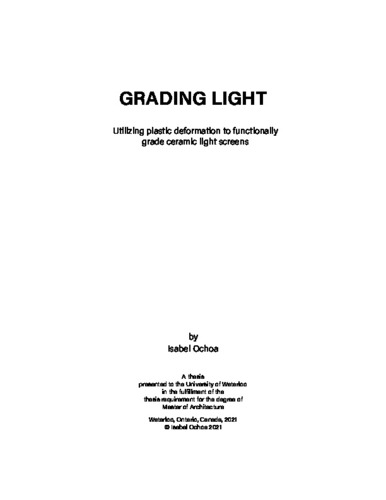| dc.contributor.author | Ochoa, Isabel | |
| dc.date.accessioned | 2021-12-23 13:40:45 (GMT) | |
| dc.date.available | 2021-12-23 13:40:45 (GMT) | |
| dc.date.issued | 2021-12-23 | |
| dc.date.submitted | 2021-11-30 | |
| dc.identifier.uri | http://hdl.handle.net/10012/17807 | |
| dc.description.abstract | When interacting with light, surface geometries and clay bodies can work together to heighten the perception of depth and alter illumination. This thesis investigates how clay 3D printing can generate materially responsive engagements between ceramics and light. A computational methodology is developed to produce texture and sculptural relief in ceramic surfaces. Liquid Deposition Modeling is used to study the plastic deformation of clay during wet-processing. Most 3D printing technologies are currently conceived as end-stage production processes characterized by high-fidelity between digital models and physical outputs. Stoneware and porcelain have a wide variety of working properties and ceramic traits that demand new approaches to digital tooling. By making the study of material behaviour essential to the design process, clay 3D printing enables non-linear design-to-production systems. The research outputs are a series of stoneware and porcelain screens that vary in brightness and illumination based on how light may be obstructed, reflected or transmitted across their surfaces. Prototypes are developed at full scale to understand the relationship between sensory engagement and material properties.
The scope, context and research methods are divided into three parts:
Light and Ceramic Material Performance– Explains stoneware and porcelain’s performance capabilities in the context of Functionally Graded Additive Manufacturing.
Ceramics and Digital Fabrication– Explains the tools by which the research methods are produced in the context of how tool path design is being leveraged in the practice of digitally crafted ceramics.
Methodology– Outlines the methods involved in making qualitative changes to alter light-scattering behaviour in 3D printed clay screens. The research is structured around a series of four light screen typologies. Each typology utilizes unique digital and physical tooling methods, harnesses plastic deformation, structural capabilities, and light scattering behaviour in porcelain and stoneware structures. | en |
| dc.language.iso | en | en |
| dc.publisher | University of Waterloo | en |
| dc.subject | Material Research | en |
| dc.subject | Ceramics | en |
| dc.subject | Computational Design | en |
| dc.subject | Additive Manufacturing | en |
| dc.title | Grading Light: Utilizing plastic deformation to functionally grade ceramic light screens | en |
| dc.type | Master Thesis | en |
| dc.pending | false | |
| uws-etd.degree.department | School of Architecture | en |
| uws-etd.degree.discipline | Architecture | en |
| uws-etd.degree.grantor | University of Waterloo | en |
| uws-etd.degree | Master of Architecture | en |
| uws-etd.embargo.terms | 0 | en |
| uws.contributor.advisor | Correa, David | |
| uws.contributor.affiliation1 | Faculty of Engineering | en |
| uws.published.city | Waterloo | en |
| uws.published.country | Canada | en |
| uws.published.province | Ontario | en |
| uws.typeOfResource | Text | en |
| uws.peerReviewStatus | Unreviewed | en |
| uws.scholarLevel | Graduate | en |

